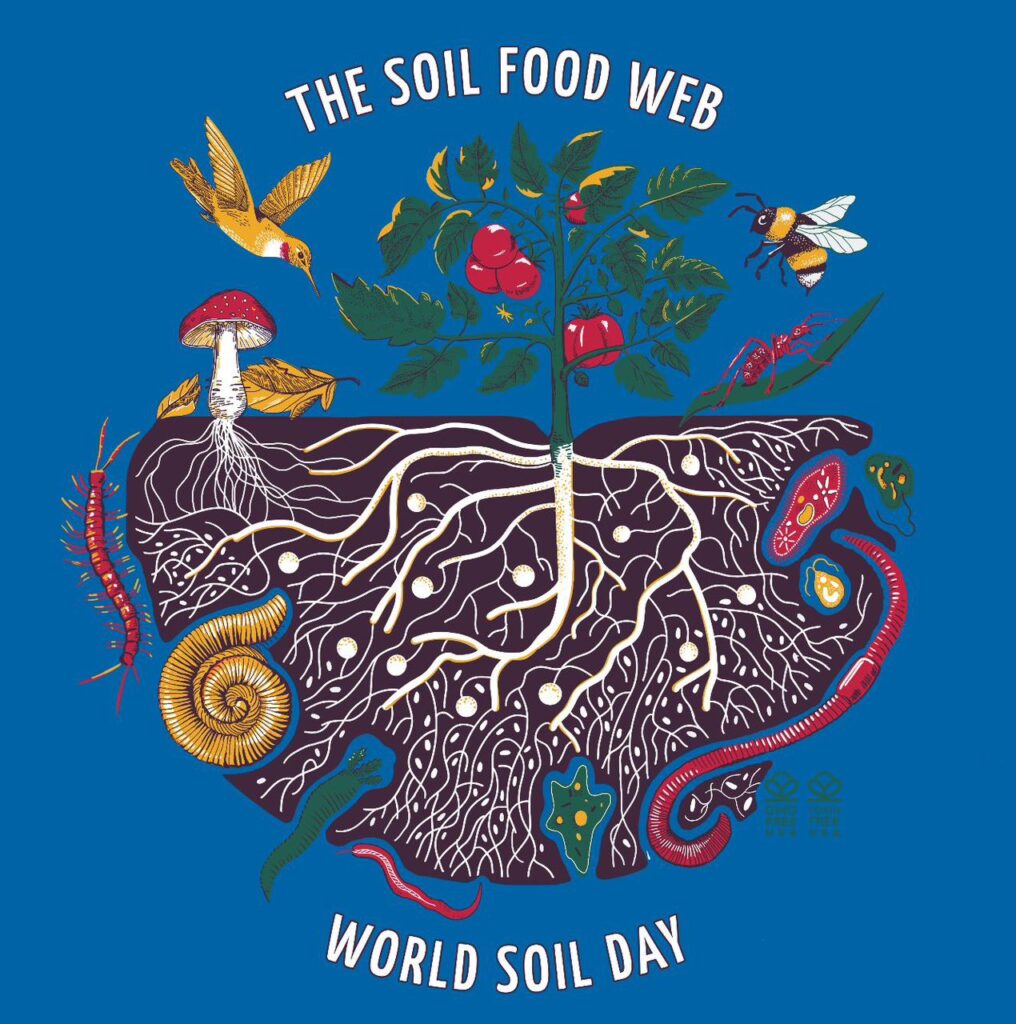
Due to human mismanagement of soil and monoculture production systems, insects and pathogens have become a greater threat to economic viability in conventional agriculture. In turn, many farmers are adopting conservation tillage practices, such as no-till farming or ripping. These approaches aim to minimize soil disturbance, maintain soil health, and reduce the need for excessive chemical inputs. Regenerative farming practices focus on working with natural processes to enhance soil fertility and reduce environmental impact. Remember that healthy SOIL contains a diverse, well-balanced soil food web that requires aerobic conditions.

The Soil Food Web Approach works by using a totally different paradigm; by making certain the plant obtains all the nutrients it needs, so that the plant’s immune system is functioning to prevent attack by insects and pathogens.
Keep Soil Aerobic
Microbes allow plants to absorb the nutrients from the air and soil. The atmosphere is 78 percent nitrogen, plants can harvest some of that for free. Let complex microbes solubilize the unused phosphates in your soil for additional uptake of nutrients, this results in a healthier and more productive plant and root structure.
Benefits of Microbes in Soil
Decompose organic matter. Foster soil aggregate stability. Recycle and regulate carbon, nitrogen and phosphorous. Fix nitrogen for plant uptake Increase the available plant root area for nutrient uptake. Degrade pesticides Improve soil structure Help control diseases.
Our Process
Inoculum increases crop yields by enhancing the soil that helps build the root structure of plants and agricultural crops. It decreases reliance on synthetic fertilizers by building and activating the microbes in the soil. Our microbial blend is specifically formulated to extract nitrogen from the atmosphere as well as solubilize from the unused phosphorus in the soil for additional nutrients.
Soil Biology Consultants
Will help farmers to inoculate their soils with beneficial biology.

Soil Biology Lab Technicians
Play an important role as microscopy opens a window in which they can really see what is happening to the life of the soil over time.

Microbial Producers
Producers of biologically complete compost and liquid soil amendments will provide their high value products to local farmers and growers.


Unlock the secrets to successful farming and rearing with the Digital Online Learning and eBooks! Explore an extensive collection of eBooks, carefully crafted by industry experts, to help you master the art of agriculture. Agroecology information🌱 is a critically important input that is often overlooked in agricultural public policies, whether rightly or wrongly. Just as 👩🏾🌾farmers👨🏾🌾 need fertilizers, seeds, and equipment for their production, they also need to be nourished with timely and relevant information about their sector to assist them in decision-making. What are the challenges of agricultural information?🌍 AGROECOLOGIC is initiating the ONLINE LEARNING & eBOOKs of a scientific review on the state of agricultural information. From organic farming techniques to livestock management, poultry farming to aquaculture, we have eBooks that cover all aspects of farming and rearing. Instantly download and access these valuable resources to enhance your skills and maximize your agricultural success.
Visit our patreon.com/agroecologic and embark on a journey of knowledge and growth. Invest in your future as a successful farmer today.

Symbolism of Asase Ye Duru
Asase Ye Duru is an Adinkra symbol that represents power, divinity, providence, and importance of Mother Earth for human life. To the Akans, it’s a reminder to nurture and respect the Earth. Asase Ye Duru is one of the most popular West African symbols that literally means ‘the earth has weight’. It’s formed from two heart-like shapes placed on top of one another, with the points facing in opposite directions. The Akans regard it as a symbol of the earth’s significance and a reminder that humans should respect the earth, and not act in ways that could harm it. The earth sustains life, so it’s crucial that we take care of it, leaving behind a clean, safer, and sustainable environment for future generations. The Asase Ye Duru symbol also represents the Earth/ fertility goddess in Akan religion and widely revered by the Bono people of Ghana. Also known as ‘Aberewaa’ or ‘Mother Earth’, she was a highly powerful and respected deity among the Akans. She was the wife of Nyame, the sky god, who created the universe. She had several children by him, including Bea, Anansi (the trickster), and Tano. Although there are no temples dedicated to Asase Ya, the people of Bono typically worship her in the agricultural fields. They make offerings and sacrifices in her honor, with the belief that the goddess would give them her blessing.
THEMATIC AREAS
Agroecological approaches: highlighting the best practices that enhance soil fertility, increase productivity, ensure nutrition and health, and demonstrate that they are done without harming the environment and are culturally appropriate.
Research and science: highlighting research results demonstrating both the socio-economic and ecological value of agroecology. Research related to socio-economic and ecological resilience, soil fertility, productivity, gender sensitive and participatory technology development, and labour.
Policy and institutional matters: exploring policy spaces related to agricultural resilience to climate change. What do the National Adaptation Plans say about agroecology? What about the UNFCCC Koronivia Joint Work on Agriculture? Does agroecology have a role in Nationally Determined Contributions? and what about the nine climate actions that are proposed by the UN Secretary General? What are the institutional mechanisms at national and regional level to mainstream and advance agroecology in major development planning, notably in agricultural and climate change adaptation related initiatives?
Principles and guidelines for an effective process for scaling up of Agroecology for resilience to Climate change; How to effectively create an effective enabling environment in support of local government and rural communities to rapidly adapt and spread an integrated, systems-oriented approach for promoting agroecology.
Become a Regenerative Agriculturalist at Home
Whether you’re a farmer, a gardener, or a consumer, you can join the regenerative agriculture movement.
Be a voice for soil: Demand proper stewardship of our land through regenerative agriculture. Talk to your neighbours and local policymakers. Support organizations that are trying to build better soil.
Talk to a farmer or rancher: Knowing who grows your food, how they grow it, and where it’s grown is a crucial step toward building regenerative food systems and shortening our agricultural supply chain. The next time you’re at a grocery store or supermarket, ask the store owner what they know about the food they source. Connect with your local farmers at a farmers’ market or farm visit and ask them about their soil practices. Consider subscribing to a local Community Supported Agriculture (CSA) farm.
Compost at home: Divert your household food waste from the landfill while closing the loop of our nutrient-and-soil cycle.
Be a regenerative agriculture consumer: Know how your food is sourced and choose meat, dairy, and produce that are grown to help regenerate land. When dining out, opt for restaurants that source ingredients from regenerative farmers.
Grow your own food: Follow regenerative agriculture techniques no matter what size your plot is. Feel empowered to start your own regenerative garden.
Agroecology communicators, research institutions, extension workers, please send your submissions to info@agroecologic.org